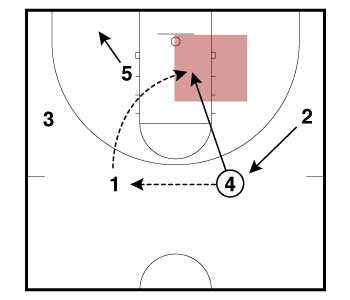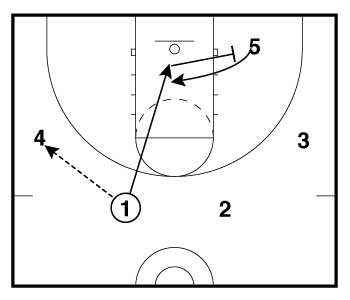07 Feb Now is the best time to simplify
I recently came across a story that I think applies to the Read & React (and perhaps basketball coaching in general). It's the story about an Indian Fish shop (actually, you can find it in a variety of cultures) and you can read the original...
03 Feb Read & React: Post & Perimeter Drill
Here's a drill that Randi Peterson developed and shared at last year's Beyond the Basics Clinic in Cedar Rapids (her team is currently 18-2 and ranked #23 nationally, by the way). If you're interested, you can watch full Coe College Women's games here. Coach Peterson has a knack of integrating the Read & React Offense into as many facets of her practice as possible in fun, imaginative ways. This particular drill is designed to train Post Moves, Post Cuts, Perimeter Shots, Post Feeds, and several other key aspects of the Post and Perimeter game. All of that work in a single drill - that's how you make the most out of practice time! There are two things that I want you to notice specifically. First, with only slight variations, this drill's framework can be used to work on specific post moves, specific post feeds, and specific post cuts. It's all about what you teach and what your team needs to work on. Second, Randi doesn't dictate the rotations; she lets the players figure it out. Not only does this save her office time because she doesn't have to conceptualize the perfect drill complete with perfect rotations, it also forces her players to be proactive and empowers them to make decisions. Just like they have to make in game situations.29 Jan 4 OUT Weak-Side Lob
I was recently at a Shorter University women's game watching them dismantle their opponent. This is their first year with the offense, but I noticed one action (or sequence of actions) that they went back to time and again with success.And, I think you might be able to find a place for it - especially if you do anything in the 4 OUT.

Here's the whole concept in one frame. 4 (who was their best offensive player) has the ball and the post is on the weak-side. 4 passes to 1, then basket cuts. Instead of trying to hit the cutter right away, 1 lobs over the top into the shaded area.
I'm not exaggerating when I say that this was good for a lay-up two or three times (at the college level, no less) and when it wasn't, their best player still caught the pass cleanly and then got to work her skills on the low block. Not once did this pass get tipped or thrown out of bounce (of course, your mileage may very on that one, I guess).
27 Jan Phoning it in: a call with PGC about the Read & React
As some of you may have known (and hopefully participated in), PGC Basketball held its first Coaching Clinic Telephone Call last Sunday night with Rick as their guest clinician. And, they were kind enough to give us a copy of the audio file from that...
22 Jan Linking Layers Together: Shorter University
Here are some Read & React clips from Shorter University men (from the 2010 season). This is Shorter's first year with the offense, but these clips will demonstrate how linking just the first 6 layers can be effective, even at the collegiate level. Clips 1 & 2: Here you can see Pass & Cut followed by the Draft Drive (for more info about the Draft Drive, see this earlier post). Basically, after a few passes and cuts, the ball handler drives off the tail of the previous cutter. You can see how the cutter drags his defender out of help-side position, opening up a seam for the penetration to get to the rim. Even in Clip 2, when the penetration comes late, the help-side defender is so preoccupied with the filling cutter that he doesn't even notice the drive until it is too late.12 Jan Going Deeper into Post Cuts
In a previous post, we took the Pass & Cut layer and added some depth to the options. That gave us the Puppy Dog Front Cut and the Draft Drive. Now, in Layer 2, we'll look at going deeper into the Post Cuts - notice that I've used the Laker Cut in the examples, but the other Post Cuts (X and Relocate) could work too. These are clips from the University of Iowa, but the principles (especially in these early layers) can be used at all levels. Next time you want to add something to your Read & React attack, at least consider going deeper in the layers you already have in place rather than defaulting to adding more layers. You may be surprised at what you can get.10 Jan 5 OUT Quick Hitter
If you've run the Read & React for long or if you've been following the Read & React at all, you know that we suggest the R&R as an alternative to set plays. (Actually, we suggest it as an alternative to anything, but plays are...
06 Jan Best of Tribe 2010
On March 1st of 2010, we started this Tribe project for all of those coaches running the Read & React. It was designed to provide you with ongoing tips, resources, and community to help you constantly improve as a Read & React coach. But, of course,...
03 Jan 4 OUT Quick Hitter
Over the last few weeks, we've been fleshing out a 5 part series on Read & React Quick Hitters. This is our fourth installment - you can find the three previous here, here, and here. This is an easy 4 OUT Quick Hitter that utilizes the Post as a scoring opportunity and as a screener. 1 passes and cuts (1st Option).
If 1 is not open, then 1 screens for 5 in the short corner.
5 cuts to the front of the rim (2nd option).
1 passes and cuts (1st Option).
If 1 is not open, then 1 screens for 5 in the short corner.
5 cuts to the front of the rim (2nd option).


